Bodegas: The small corner shops that run NYC
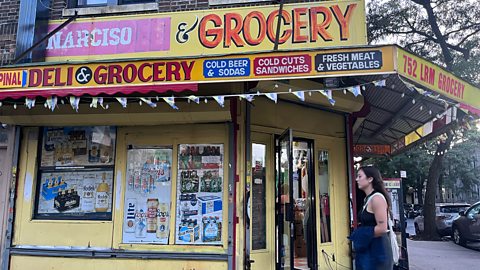 Pierina Pighi Bel
Pierina Pighi BelWant to feel like a local in one of the world's most international cities? Head to these beloved neighbourhood stores spearheaded by Hispanic entrepreneurs.
It's 07:00 in Brooklyn's East Flatbush neighbourhood and Yovanna Melo is busy answering the phone while jotting down breakfast orders. Every morning, calls from busy New Yorkers in English and Spanish come into her bodega (a small neighbourhood grocery store), asking for beiconeganchí (bacon, egg and cheese melts), pavo dulce (honey turkey sandwiches) and pan con bistec (Cuban-style steak rolls) to help them power "The City That Never Sleeps".
Berlin has its Spätis, Japan has its convenience stores and New York City has its beloved bodegas. According to the city's Health Department, some 7,000 bodegas dot the city, and you can hardly walk two blocks without stumbling upon one of these handy, all-in-one convenience stores that have historically been owned by members of the Hispanic community. Many are open 24/7; some feature friendly felines behind the counter; and, in a city where space is at a premium and large supermarkets can be hard to come by, all are stocked with a mixture of everyday items like eggs, tinned foods, snacks, beer, cleaning supplies, toiletries and lottery tickets.
"What I like most about being a bodeguera (bodega owner) is giving people that confidence. It pleases me to know that I serve them well," said Melo, who has owned El Vacilón (The Shindig) with her husband for 20 years since she moved to New York City from the Dominican Republic.
 Pierina Pighi Bel
Pierina Pighi BelLike so many bodegas, El Vacilón isn't just a store. Melo knows many of her customers by name, trusts them to come back to pay for sandwiches and goods if they don't have the time or money and even lets families drop their children at the shop while they run errands. These neighbourhood landmarks are also known to let customers send packages there and hold onto keys in lieu of a doorman. In fact, to truly understand how New York City runs and how it's changed with each successive wave of immigration, it's important to understand bodegas and the communities they serve.
The origin of bodegas
According to Carlos Sanabria, author of the book The Bodega: A Cornerstone of Puerto Rican Barrios, these neighbourhood shops likely originated with Spanish and Cuban immigrants in the early 1900s. As Puerto Ricans began migrating to New York City in large numbers in the 1920s (after the island became part of the US in 1917), they took over the stores, which came to be known as bodegas, a Spanish word that initially meant "wine cellar" or "warehouse". While many NYC grocery stores continued to be owned by Irish, Italians, Jews, Greeks, Germans and other immigrants, these small corner shops became especially associated with the Puerto Rican community.
Bodegas provided food from the island that was hard to find, like dried codfish, papaya and guava preserves, plantains, chorizo sausages, spices, green banana cakes and mondongo (tripe), among others. They also carried other items like religious candles and recordings of Puerto Rican and Latin music.
"By the late 1920s, there were an estimated 150,000 to 200,000 Puerto Ricans living in New York, and they were served by more than 200 bodegas and colmados (bodegas in the Dominican Republic)," writes Andrew F Smith in New York: A Food Biography.
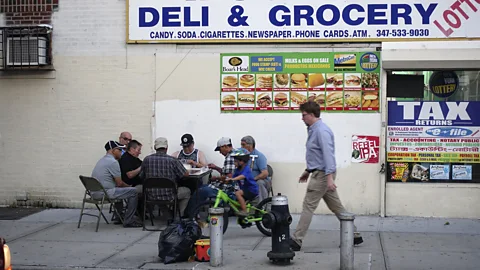 David Grossman/Alamy
David Grossman/AlamyAfter World War Two, Sanabria says the Puerto Rican population in NYC increased to more than 600,000, and their bodegas began to spread from East Harlem in Manhattan and Gowanus in Brooklyn into neighbourhoods like the Lower East Side, Spanish Harlem, the Upper West Side, the South Bronx and Williamsburg. Like a communal living room, bodegas served as vital centres for Puerto Rican immigrants to socialise, get information about employment or housing, or buy goods on credit if they were short on money.
"Bodegas became the social hub, the social network. Anything that was happening, you could find out in the bodega, even the bad rumours," said documentary filmmaker Lilian Jiménez. "Bodegueros were highly respected and people trusted them. My mother would say, 'If you ever get into trouble, run to the bodega'."
Bodegas today
Many bodegas have changed in recent decades with the city's shifting social and demographic trends. When early Puerto Rican bodega owners decided to retire, many of their children didn't necessarily want to take over the family business, so they sold their bodegas to Dominicans, who started arriving in New York City in large numbers in the 1980s. Today, the amount of Dominican immigrants in NYC is nearly seven times that of elsewhere in the US, andaccording to Christian Krohn-Hansen, author of the book Making New York Dominican: Small Business, Politics, and Everyday Life, by 1991, Dominicans owned roughly 80% of the Latinx-owned bodegas in NYC.
Just as their Puerto Rican predecessors did, Dominican bodegueros cater to their fellow compatriots, selling dishes like the popular mangú (boiled mashed plantains), arroz con habichuelas (rice and beans), chicken chicharrones (fried pork belly or rinds), frituras (fried treats), sausages, fried cheese and sauteed onions.
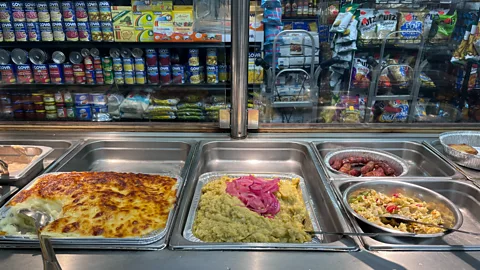 Pierina Pighi Bel
Pierina Pighi BelMexicans, who started arriving in large numbers to NYC in the late 1980s, also now own many bodegas. There are even some "bodegas/taquerías" that sell tacos, notes Zilkia Janer in her book Latino Food Culture. Other bodegas are now owned by Yemenis and East Asians, too.
According to the NYC Department of Health, a bodega is now defined as any store under 300 sq m that sells milk, meat or eggs but is not a specialty store (bakery, butcher, chocolate shop, etc) and doesn't have more than two cash registers. But ask many New Yorkers and they'll offer a more colourful explanation of what makes a bodega a bodega.
"If there is not a cat, it's not a bodega," said Melisa Fuster, author of the book Caribeños at the Table: How Migration, Health, and Race Intersect in New York City, referring to the many bodegueros who let their felines roam inside their stores. Back when Fuster, who is Puerto Rican, used to live in New York, she said, "I would go to bodegas for specific Puerto Rican food that I would not see at supermarkets, like platanutres (plantain chips), sancochos (stews); it was a little bit of nostalgia," she recalled.
While these uniquely New York establishments face threats like gentrification and rising rents, they continue to power the city.
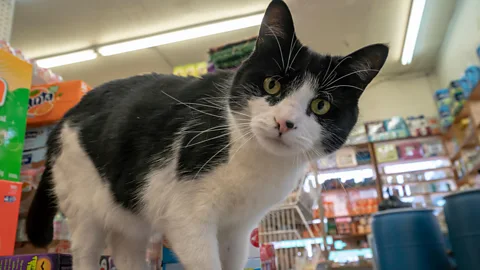 Paul Matzner/Alamy
Paul Matzner/Alamy"Bodegas are the most resilient establishments, so they survive," said Rachel Meltzer, author of the research paper Bodegas or Bagel Shops? Neighborhood Differences in Retail and Household Services. "They can exist in a really small space, and adapting their products to their communities' demands is not very costly. Also, NYC is so big and dense that in a small radius around a bodega, you will have a ton of people, so it is economically viable."
For Melo, bodegas embody the rapid pace of the city, allowing New Yorkers to dash in for a quick coffee or call ahead for a hot sandwich that's ready when you run in.
"[New Yorkers] don't want to go to the supermarket because they have to stand in a long line to pay for a gallon of milk, so they go to a bodega because it's faster," she said.
According to Radhames Rodriguez, who moved from the Dominican Republic in 1985 and now owns the Pamela Green bodega in the Bronx, ultimately what makes these stores unique is the intimacy between bodeguero and bodega customer.
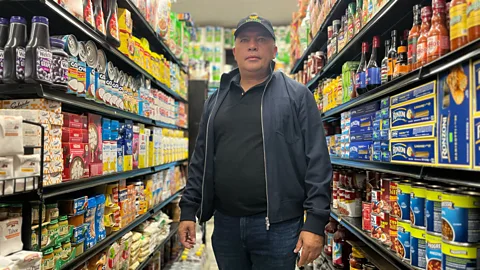 Pierina Pighi Bel
Pierina Pighi Bel"When you go to a bodega, they greet you, ask how are you doing, how is your family doing. I already know how my customers like their coffee and their sandwiches. There is a very close integration with people," said Rodriguez, who founded the United Bodegas of America (UBA) association in 2018 to offer bodegueros better access to security cameras and protection from robberies, among other purposes.
But despite adversities, he loves working at his bodega. "For me, it is like therapy. I love contact with people. Behind the counter, I feel like Frank Sinatra singing at a concert. I love greeting and serving clients; it gives me great satisfaction," he said.
Ask any New Yorker and they'll tell you this is a city of neighbourhoods. So for visitors, there is perhaps no better way to make this endlessly big, multicultural metropolis somehow feel like home than by stopping into your local bodega for a chat. Whether you're grabbing a morning sandwich or some late-night ramen, chances are you'll come away with a smile – and feeling more like a local in the process.
Join more than three million BBC Travel fans by liking us on Facebook, or follow us on Twitter and Instagram.
If you liked this story, sign up for the weekly bbc.com features newsletter called "The Essential List". A handpicked selection of stories from BBC Future, Culture, Worklife and Travel, delivered to your inbox every Friday.
